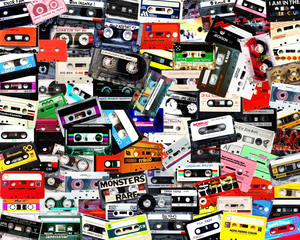 Do you have boxes of old cassette tapes you want to digitize and bring into the modern world? Digitizing cassette tapes to create MP3 files is pretty simple, almost as simple as playing a cassette tapes. There are a range of cassette players available with a USB port, making the task of creating MP3 files from your old cassette tapes very simple.
Do you have boxes of old cassette tapes you want to digitize and bring into the modern world? Digitizing cassette tapes to create MP3 files is pretty simple, almost as simple as playing a cassette tapes. There are a range of cassette players available with a USB port, making the task of creating MP3 files from your old cassette tapes very simple.
Why would you want to digitize your old cassette tapes? Back in the day we thought cassette tapes were a great convenience, but now they're old and klunky, right? Digitizing the tapes means you can store that audio in your computer and/or MP3 player, and get rid of the tapes themselves. If it's a music tape you'll get better audio by buying the music through a service like the iTunes Music Store. But what if the tape is something else, like recordings of classes you took, or of friends or family that are now dead? In other words, not all cassette tapes are just mass market music you could simply re-purchase through iTunes. There might be sentimental value to digitizing a specific tape.
The first step is to locate audio recording software to use. A free, and excellent, choice is the open source Audacity software. Audacity not only records audio, but it has top-notch audio editing and features. See http://audacity.sourceforge.net/ to get the software.
Out of the box Audacity doesn't support saving audio in MP3 format. It does support saving audio in WAV format, and WAV is the preferred format to store audio that you'll later edit. That's because WAV has no compression, and therefore you don't lose any audio quality when editing or processing WAV. MP3 on the other hand is a lossy compression format, meaning that every time you re-save an MP3 file it loses a bit of fidelity. It's better to think of MP3 as the destination, and to not edit MP3 but to edit WAV files then convert them to MP3 when your editing is finished.
There are instructions on the Audacity website to add MP3 export support to Audacity.
Another option for Mac users is Garageband.
With that out of the way there are approximately three ways to digitize audio into your computer. All three methods appear to Audacity, or other sound recording applications, as an audio input device.
Generally speaking the process is to launch the sound recording application, make sure it has selected the correct audio input device, click the record button in the software, then on the cassette player press the play button. Keep recording until the cassette is finished playing.
Line input on sound card: Many computers come bundled with an audio device that includes a line-level input. That input might be meant for headphone jacks so you can use an audio headset with Skype or other applications.
What's required is a cassette player with a line-level output. I believe this is different than a headphone output. All cassette decks have a line-level output, because that's how the cassette deck is meant to be connected to a stereo system. Connecting it to the computer is simply a matter of getting the right cable with plugs to match those on the cassette deck and the line-input on the sound card.
USB audio interface: There are also USB based audio cards that supposedly give better sound quality. Everything I just said about sound cards built into computers apply to USB audio interfaces.
USB Cassette player: The final method is the cassette players with a USB interface. Those devices are much simpler because you just connect the USB cassette player to the USB port on your computer. There's no chance for confusion over what line level audio is, or how to get the right cable. It's just like the USB interface you use for all the other computer gizmos in your life, like the mouse or keyboard.
